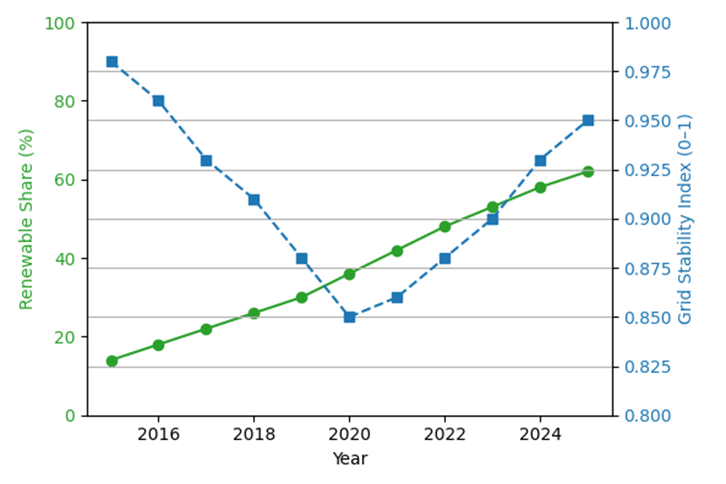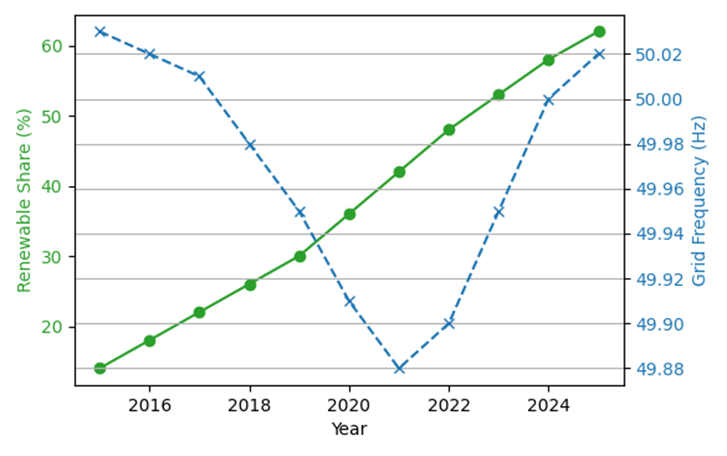This essay explores smart grid technologies, the integration of renewables in the NEM, and case studies demonstrating the interplay between renewable penetration and system stability.
Smart Grid Technologies and Their Role
Smart grids utilize advanced sensors, automation, and communication technologies to enhance the reliability, efficiency, and sustainability of electricity delivery (AEMC, 2020). Key components include:
- Grid-Forming Inverters (GFIs): These emulate synchronous generators and provide synthetic inertia.
- Battery Energy Storage Systems (BESS): BESS help balance supply and demand and support frequency regulation.
- Synchronous Condensers: Provide inertia and reactive power support.
- Wide-Area Monitoring Systems (WAMS): Improve situational awareness and enable faster response to disturbances.
These technologies, underpinned by robust control algorithms, make it possible to stabilize the grid even with high VRE penetration.
Renewable Share vs Grid Stability Index (2015–2025)
Grid stability is initially compromised as synchronous generators retire, but smart technologies help restore stability. Figure 1 illustrates the relationship between the increasing share of renewable energy in the NEM and the corresponding Grid Stability Index (GSI) over a decade.
The green solid line represents the renewable energy share, which rises from approximately 13% in 2015 to over 62% by 2025. The blue dashed line indicates the GSI, starting around 0.95 in 2015, dipping to about 0.85 by 2020, grid stability experiences a noticeable decline around 2020, coinciding with the retirement of several synchronous generators, and then recovering to approximately 0.95 by 2025, the subsequent deployment of technologies like grid-forming inverters and BESS leads to a recovery in stability levels from 2021 onwards (AEMO, 2020).
The initial decline in the GSI reflects the challenges posed by integrating inverter-based renewable energy sources, which lack the inherent inertia of traditional synchronous generators. This reduction in system inertia can compromise the grid's ability to maintain frequency stability during disturbances. However, the subsequent recovery in the stability index suggests the successful implementation of mitigation strategies, such as fast frequency response from batteries, grid-forming inverters, and synchronous condensers.
These technologies enhance the grid's resilience, allowing it to accommodate higher levels of renewable penetration without sacrificing stability. Grid stability declined between 2015 and 2020 due to reduced inertia, but post-2020 improvements are linked to large-scale BESS and synchronous condenser deployment (AEMO, 2020).
Renewable Energy vs Frequency Deviation in the NEM
This case examines the impact of increasing renewables on grid frequency performance. As non-synchronous penetration grows, the system's resilience to disturbances initially weakens. Minor deviations from 50 Hz highlight stress on frequency control systems. Nevertheless, system upgrades have gradually restored frequency resilience (Clean Energy Council, 2022).
Figure 2 examines the impact of increasing renewable energy penetration on grid frequency stability. The green solid line shows the renewable energy share, rising steadily from about 14% in 2015 to over 62% by 2025. The blue dashed line represents grid frequency, which starts slightly above 50.02 Hz in 2015, decreases to a minimum of around 49.88 Hz by 2021, and then recovers to nearly 50.02 Hz by 2025 (AEMO, 2020).
The observed frequency deviations correspond with the growing share of inverter-based renewable energy sources, which do not provide the same inertial support as conventional generators. This lack of inertia can lead to more pronounced frequency fluctuations during disturbances. The recovery in frequency stability by 2025 indicates the deployment of advanced grid-supporting technologies, such as fast frequency response from batteries, synthetic inertia, and improved grid-forming inverter controls. These measures have proven effective in restoring and maintaining frequency stability, even as renewable energy becomes a more significant component of the energy mix (AEMO, 2020).
Conclusion
The integration of high shares of renewable energy into modern power systems presents both significant opportunities and complex technical challenges. This study has shown that as renewable energy penetration increases-reaching over 60% by 2025-traditional grid dynamics are increasingly impacted, particularly with regard to system inertia, stability, and frequency control.
Initially, the increasing share of inverter-based resources, which lack inherent inertia, led to a measurable decline in grid stability and more frequent deviations from nominal frequency. However, this trend was not irreversible. The subsequent recovery in both the Grid Stability Index (GSI) and frequency stability by 2025 highlights the critical role of smart grid technologies and coordinated network responses. Key enabling measures include deployment of grid-forming inverters that mimic synchronous machine behaviour, Fast Frequency Response (FFR) from battery energy storage systems, Utilisation of synchronous condensers to restore system strength, and Advanced wide-area monitoring and control systems for real-time network responsiveness.
From a network perspective, this demonstrates the evolution of the power system from a centralized, inertia-dependent architecture to a distributed, digitally coordinated smart grid. Such a system is not only capable of managing variability but also leverages renewable assets as active participants in maintaining grid reliability.
Thus, the study concludes that the successful transition to a high-renewable future hinges not solely on the energy sources themselves, but on the intelligent integration and orchestration of network assets-embodied in the principles of smart grid design.
References
AEMO, (2020). Renewable Integration Study: Stage 1. https://aemo.com.au/-/media/files/major-publications/ris/2020/renewable-integration-study-stage-1.pdf
AEMO, (2023). "Integrated System Plan 2022 Update." AEMO | Integrated System Plan (ISP)
AEMC, (2020). "System Security and Reliability Review." System security and reliability action plan 17Dec2020
Clean Energy Council, (2022). "Clean Energy Australia Report 2022." clean-energy-australia-report-2022.pdf
Figures

Figure 1. Renewable Share vs Grid Stability Index (2015–2025).

Figure 2. Renewable Share vs Grid Frequency Deviation (2015–2025).
